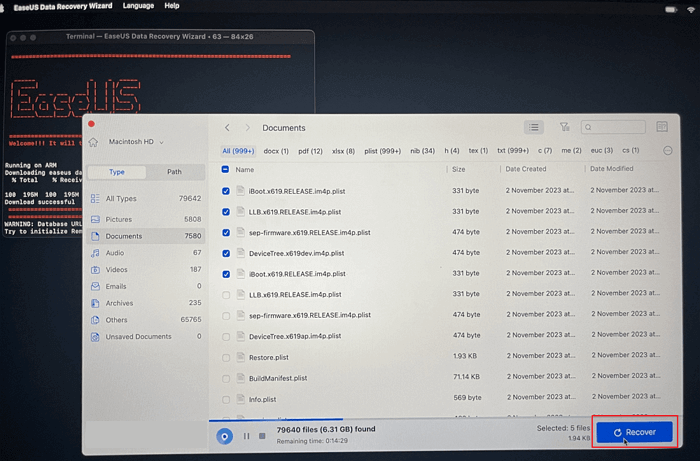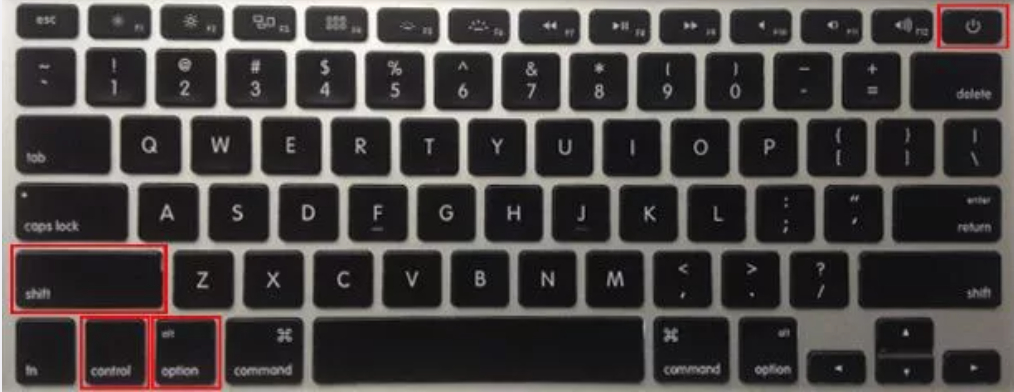Quick access to the 10 troubleshooting methods to fix the Macbook or iMac won't turn on problem:
| Workable Solutions | Step-by-step Troubleshooting |
|---|---|
| Basic Troubleshooting |
|
|
Advanced Troubleshooting |
|
What Causes MacBook or iMac Failing to Turn on
Opposite to Mac won't shut down, Mac won't turn on is an issue that Mac users have been facing in the past. There are various reasons which can prevent your Mac from booting. Let's see the possible reasons behind the startup failure on Mac:
- Component Failure: Your Mac works using a keyboard, screen, SSD drive, battery, and touchpad. If any component is misbehaving, it can prevent your Mac from startup.
- System Management Controller (SMC) Problem: SMC is responsible for handling all the power supplies to your Mac. So, whenever you turn your Mac on, SMC does its job to handle all power-related issues. If SMC fails, your Mac won't boot.
- Battery: Without a power cable, your Mac runs on the battery. If your battery is insufficient, your Mac won't work.
- Broken Applications: Any firmware or startup application misbehaving or not working can also cause problems with Mac startup.
These are some of the key reasons that can create problems for your Mac.
How to Get Your Data Off a Mac That Won't Boot
The essential thing in your Mac is your data. So, if your Mac isn't working, how can you get your data off of your Mac? Luckily, you can do that with the help of EaseUS Mac data recovery software.
The top-rated Mac data recovery software can help you recover data from a dead Macbook. It works even if your Mac fails to load the macOS.
The software provides a bootable recovery method for your Mac. Using its bootable recovery feature, you can quickly rescue all your data files on Mac even if it does not boot.
Let's see below how to rescue data from an unbootable Mac using EaseUS Data Recovery Wizard Pro in the Mac Recovery Mode:
Step 1. Launch EaseUS Software in Recovery Mode
Select "Utilities > Terminal" from the top menu, and enter the command sh <(curl https://d3.easeus.com/mac/boot.sh). Hit "Return". Wait for the application to open, and it will take several minutes.

Note: If the Terminal displays either "No such file or directory" or "Could not resolve host," you should verify that the command line you entered is correctly spelled, ensure your Mac has a stable internet connection, and confirm that your macOS version is not lower than macOS 10.15.
Step 2. Select the Volume on Your Mac Hard Drive
Select the volume where your lost data is stored, and click "Search for lost files". The EaseUS software will quickly locate all the recoverable data on the selected volume.

Step 3. Choose the Lost Data You Want
EaseUS software categorizes the scanned recoverable data by file type and storage path. Find the data you want by clicking "Type" or "Path" in the left panel. Then, check the boxes in front of the data you want to recover.

Step 4. Recover and Save Data on an External Disk
Click the "Recover" button, and a pop-up window will show up saying, "Please select a target location to save". Choose the external disk as the new storage location of your recovered data.

Follow the 10 Fixing Methods to Repair a Mac That Won't Turn on
It is recommended to stay on the safer side and rescue your data first using the EaseUS Data Recovery Wizard for Mac. Once done, you can use the below methods to fix your Mac that won't boot.
Fix 1. Check Power Status
As you know, that Mac will boot if your battery has sufficient capacity. If not, you need a power cable to boot your Mac. Therefore, you have to check your Mac's power status.
If your battery isn't working, try to plug in the charger and see if your Mac is charging. Also, make sure that your power cable adapter is in good condition. Replace the charger if its cable is broken.
Fix 2. Assess the Signs Indicating Power on
Identify that your Mac is at least turning on by assessing some key signs. There are various ways to assure that Mac is loading up, such as:
- Hit the power button and see if you can hear the fan's noise.
- Check if any light on your keyboard is lighting up. Also, see power cable light is enabled.
- Press the Caps Lock key and look if it lights up.
If you can not see any sign, then the apparent reason would be that your Mac is not getting a Power supply. You need to try different chargers or fix the power supply port.
Fix 3. Disconnect Peripheral Devices
Try unplugging all the peripheral devices from your Mac. Such as an external mouse, keyboard, HDMI, printers, etc. Sometimes, an external device can have a short circuit inside of it. Hence, it will draw more or inconsistent power from your Mac.
SMC (System Management Controller) will prevent Mac from booting in such a scenario. So, disconnect all peripheral devices and try to power Mac again.
Fix 4. Try Mac's Power Cycle
When your Mac doesn't turn on, you can try a force restart, enabling a power cycle.
Follow the below method to enable a power cycle on your Mac:
Step 1: Keep pressing your Power button key on Mac.
Step 2: Remove all power cables.
Step 3: Hold the power button key for 10 or more seconds.
Step 4: Restart Mac again.
Fix 5. Check for Display Issues
If you are loading your Mac on an external display, there can be a problem with the external display. First, make sure that the external display has power and working.
You can also see if your Mac fan is working. In case it does, the problem is likely to be with your external display. Check and connect the external device cables correctly with power and your Mac device.
Fix 6. Check Hardware Cables
Properly connect any internal or external hardware device cables to your Mac. A loosely connected cable would be the cause for your Mac not able to boot.
Also, check that no internal or external cable is broken from anywhere. You need to replace the cable if there is any tear or fraying on it.
Fix 7. Boot Mac in Safe Mode
There is a high probability that a 3rd party application or drive issue is causing the issue with your Mac. You can try to run Mac in Safe Mode to eliminate this probability.
Safe Mode in Intel-Based Mac
You can access safe mode in Intel-based Mac by turning on your Mac and then pressing and holding the Shift key from your keyboard. Keep pressing the Shift key until you see the login screen.
Safe Mode in M1 Mac
In M1 Mac, hold the power button key until you see the startup options window on the screen. You can select the startup disk and hold the Shift key to load Mac in Safe Mode as the screen appears.
Fix 8. Use Mac's Recovery Mode
Using Mac's recovery mode, you can quickly repair your SSD, reinstall macOS, or restore Time Machine backup.
You can enter the recovery mode by turning on your Mac and immediately pressing and holding the Command + R key.
In M1 Chip, recovery mode is accessible by pressing and holding the Power Key, which will lead you to Load startup options through which you can choose the recovery option.
Fix 9. Reset SMC
Resetting SMC helps you fix low-level functions that are not working in your Mac. You can reset the SMC on your Mac by following the below steps:
Step 1: Turn off your Mac.
Step 2: Hit the Power key.
Step 3: Now, press the Shift + Control + Option + the Power Key for seven seconds.

Fix 10. Schedule an Appointment with Apple Genius Bar
If you fail to turn your Mac on with the first nine methods, it is better to reserve an Apple Genius bar appointment.
You can visit https://www.apple.com/retail/geniusbar/ and schedule an appointment with them. They can help you by providing you assistance with your Mac's issue.
Conclusion
Mac boot issues are here from the beginning. Although they rarely appear, they are frustrating and can stop you from doing your important work.
Usually, the Mac won't turn on if there are problems with your hardware components. However, you can fix the commonly occurring issues by the methods mentioned in this article.
Whenever your Mac runs into a boot issue, it's always best to rescue your Mac's data. The best approach is to use EaseUS Data Recovery Wizard Pro, which helps you perform bootable recovery on your Macbook.
Was This Page Helpful?
Daisy is the Senior editor of the writing team for EaseUS. She has been working at EaseUS for over ten years, starting as a technical writer and moving on to being a team leader of the content group. As a professional author for over ten years, she writes a lot to help people overcome their tech troubles.
Jean is recognized as one of the most professional writers in EaseUS. She has kept improving her writing skills over the past 10 years and helped millions of her readers solve their tech problems on PC, Mac, and iOS devices.
Related Articles
-
Recover Data from SanDisk on Mac | All SanDisk Storage Devices
![author icon]() Dany/Jul 24, 2024
Dany/Jul 24, 2024 -
How to Transfer Files in Recovery Mode [Full Guide]
![author icon]() Brithny/Jul 24, 2024
Brithny/Jul 24, 2024 -
How to Restore chat.db on a Mac with 4 Methods
![author icon]() Brithny/Jul 24, 2024
Brithny/Jul 24, 2024 -
Where Are Photos Stored on Mac | Find and Recover Photos
![author icon]() Dany/Jul 24, 2024
Dany/Jul 24, 2024